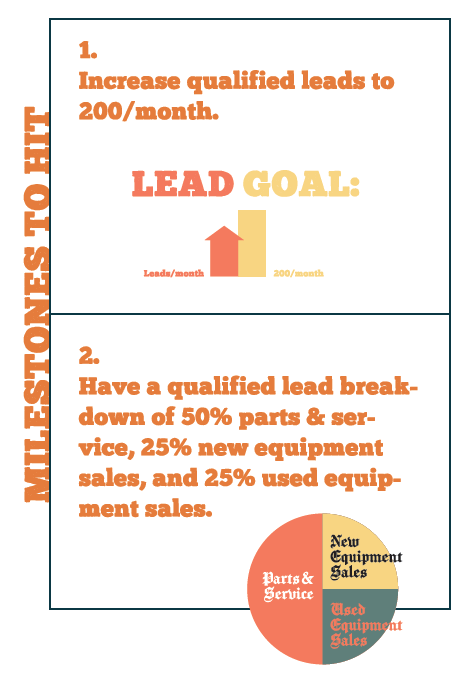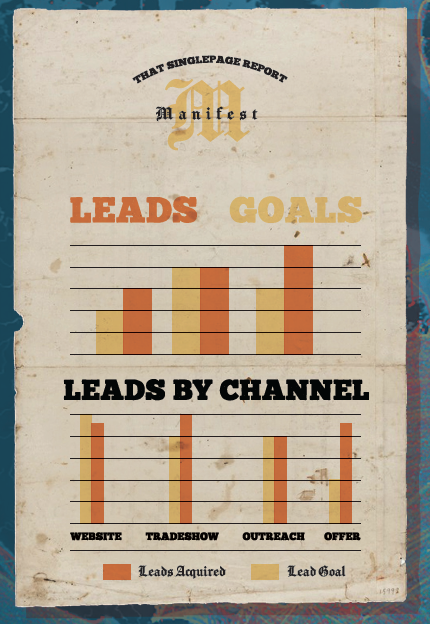A common lamentation in the SEO world is that our stakeholders just “don’t get it.” They don’t understand what you do and why it’s valuable. They think that SEO is a bunch of snake oil and you just sit around all day spamming websites asking for links.
Of course, it would be great if your stakeholders just inherently knew that the reason their phone keeps ringing, or that the sales continue to roll in, is because of your brilliant SEO work. But if you do a good job of communicating results from the very beginning of your project, you won’t need to convince them (as much) — they’ll know.
Measure What Matters
Before we dive into the data, let’s first take a step back and consider what we actually need to measure. A common mistake we see in marketing reporting is overlong reports. Remember the last time you spent six hours putting together 28 pages of sizzling commentary? Even after all that work, no one was really interested in going through it, page by page or slide by slide. Not even you.

Why is that? Why do we create reports that are so incredibly long, crammed full of charts and data and three letter acronyms? Perhaps it’s insecurity — the more information, the better, right? Unfortunately we are not paid by the number of pounds of paper we can use up each month. Instead, we’re paid for our marketing know-how. Reporting is very important, but taking screenshots for hours every month isn’t exactly a great use of anyone’s time. What to do?
Monitoring vs Reporting
What is likely happening here is that you may be mistaking monitoring with reporting. Monitoring is the data, the day to day, the checking that the graph is indeed going up and to the right as you expected. Reporting is the result, the proof that you’re going in the right direction. Or, if you aren’t going in the right direction, the knowledge of what needs to be done to correct your course.

Instead of one report, you should actually have two — a diagnostics dashboard for your own use, and a report for your stakeholders.
The diagnostics dashboard is very much focused on the here and now. Are there errors in Google Search Console that you need to check out? What about that spammy new competitor in the map pack? Rankings have dropped. Why? These are the kinds of in-the-moment, actionable concerns that your dashboard should be bringing to your attention.
Here is a perfect, real-world example of why you need this dashboard. We had a client whose developers were a little heavy handed on the code updates. Knowing this, we were watching the site using Little Warden, making sure that their Google Tag Manager code was still present.
Then on the 6th of the month, right after a major site migration, we got a notification that the Google Tag Manager code was gone. We alerted the client and the developers and the code was back on in a few hours. Imagine if we’d waited until the end of the month to pull a report, only to realize that the code had been gone for most of the month — ever since the site migration!
Monitoring for these types of issues is very important, and if you solve the issue in a timely fashion, it doesn’t even need to be added to a report. Plus, the presence or absence of your GTM code isn’t going to tell you if you’re going where you need to go. It’s like the difference between strategy and tactics — posting on Instagram three times a day is a tactic, but without knowing the why, you won’t ever see the results you want from all this hard work.
Now that you have your diagnostic dashboard complete, what’s left to go into your report to your stakeholders? Results. Specifically, results tied to goals. It’s time to sit down and have an honest conversation with your stakeholders and find out what matters most to them.
Business Goals to KPIs to Metrics
First, you need to agree on business goals for your organization. Don’t just focus on so-called “marketing” goals. Instead, lay out all the goals. What are the major milestones that your organization needs to hit this year?
Here is a recent example from one of our clients:
- Increase qualified leads to 200/month.
- Have a qualified lead breakdown of 50% parts & service, 25% new equipment sales, and 25% used equipment sales.
 These are great, measurable goals. You may have goals that are slightly less measurable. For example, “increase awareness” or “improve stakeholder engagement.” Though these can be turned into measurable goals, they’re going to need some work. Your job will be to shape these goals from formless nothings into goals that you can actually point to and say, “Yes, we got there!”
These are great, measurable goals. You may have goals that are slightly less measurable. For example, “increase awareness” or “improve stakeholder engagement.” Though these can be turned into measurable goals, they’re going to need some work. Your job will be to shape these goals from formless nothings into goals that you can actually point to and say, “Yes, we got there!”
Now, back to your stakeholder’s goals. Let’s start with the first one: Increase qualified leads to 200/month. You might be tempted to track form fills in Google Analytics and call it a day. You can do better.
Note that our client specifically mentions qualified leads, not just any lead. And of course you want to be sure that leads via SEO are just as good as leads that come from other channels. There are several ways to accomplish this but a good way to start is to record the source of every lead and then see how leads via organic search are performing. See if there is a consistent percentage of unqualified to qualified leads each month, then see if you can improve that percentage.
For example, if 75% of unqualified leads become qualified, then you’re going to need 267 form fills every month across all channels. If 60% of leads come from organic, that’s 160 leads that you’re responsible for. Now you know that you need an ongoing form fill counter in your dashboard — essentially a burndown chart for qualified leads. This way, you’ll be able to see halfway through the month that you’re going to hit (or miss!) your goal and can adjust your time and effort accordingly.
This math also assumes that you don’t have leads visiting the site multiple times before they convert, but covering multi-touch attribution is a topic for another article!
Let’s turn to that second goal: Have a qualified lead breakdown of 50% parts & service, 25% new equipment sales, 25% used equipment sales. Again, you’ll have to rely on your stakeholders to categorize those qualified leads appropriately. You might be able to get this information another way if your website has separate forms for different services or some way to differentiate the type of lead, otherwise you’ll have to rely on feedback from the CRM to get this mix. Since you already have the source saved to the lead, you can then map the lead mix by channel.
Working from our previous math, we now know that SEO needs to be responsible for 80% parts and service leads, 40% new equipment sales leads, and 40% used equipment sales leads. With this data, you can break down your burndown chart even further. You’ll not only know if you’re going to hit your total lead targets, but whether or not you’re going to hit your division targets.
By tracking leads by division, we can also see if one division in particular is struggling. Maybe that mix is starting to skew 60/20/20 instead of the goal 50/25/25. Are there more parts and service leads because overall there are more leads for that sector, or are you struggling to bring in qualified traffic to your new and used equipment pages? Having this information in hand will make a huge difference in how you approach your day-to-day SEO work. Instead of focusing on more traffic, you can laser point your efforts on where you need to be.
Building Your Report
Now it’s time to make that report. In this situation we’re covering, you only need one page to cover everything you need to report on — leads and lead mix by channel, based against your goal figures. That’s it.
It might be a shock to go from that 26-page report to a single-page report, and if you’re worried about that, start dialing things back slowly. Start with this one page, and then slowly chop away pages you no longer need off the end. Before you know it, you’ll have a single-page report. No one will miss that one page showing how many visitors you received from Luxembourg for your one location business in Chicago.

Use Their Words
In addition to making the report as short as possible, try to use the same language that the people you’re reporting to use in their day-to-day speech. When you’re having that conversation with your leadership team about goals, try to write down exactly how they phrase things. For example, do they say, “We want phone call conversions.” or do they say, “We want to keep the phone ringing.”? This will help guide the microcopy in your report and make the report more approachable.
You Shouldn’t Need To Be There
Additionally, assume that you won’t be there to explain the report. Would it make sense without you there to explain it? If not, you need to add in microcopy — little pieces of explanation to accompany your charts and graphs. Not only should the report be understandable by everyone, it should be understandable for years to come.
Avoid Tables
SEOs are big Excel nerds, present company included. This means that we often turn to tables first when a nice graph would actually be a better choice. Not everyone is comfortable with tables and numbers, plus tables take longer to review and understand compared to looking at a line or bar chart. If you must present in table form, try to include bar charts or heatmaps inside each table to highlight your most important information.
Prove Your Value
Reporting might seem like something you can put off — something that you can focus on when you have more time to do it right, and that your everything-and-the-kitchen-sink-style reports are passable for now. Based on our experience, the best time to start working on a report is when you first start that job or that working relationship with a client. The second best time? Right now.
Why? Marketers are good at marketing. Everyone’s been sold a bill of goods from a slick-talking marketer who didn’t deliver, and while you may be committed to doing things right and getting the job done, you’re dealing with years of unmet expectations from others in your industry. A clear report, without any bafflegab or useless metrics, can mean a world of difference in separating you from the rest of the pack.
People don’t switch agencies or hire new in-house marketers because they want more of the same. People make changes when they don’t understand how what you’re doing is meant to help them get to where they need to go. Clearly stated goals and clear, short, and easy to understand reports will get you where you want to go.

